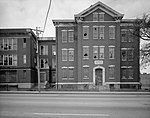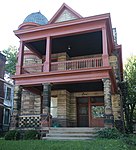DePaul Cristo Rey High School
2011 establishments in OhioAC with 0 elementsCatholic secondary schools in OhioCristo Rey NetworkEducational institutions established in 2011 ... and 4 more
High schools in Hamilton County, OhioPoverty-related organizationsPrivate schools in CincinnatiRoman Catholic Archdiocese of Cincinnati
DePaul Cristo Rey High School (DPCR) is a private, college-preparatory high school located in the Clifton neighborhood of Cincinnati, Ohio, United States. The non-diocesan school, which opened June 5, 2011, is one of 37 Catholic high schools that serve the Archdiocese of Cincinnati. Named after St. Vincent de Paul, it is operated by the Sisters of Charity of Cincinnati as the 25th member of the Cristo Rey Network of work-study schools that target students from low-income families who could not otherwise afford a college education.
Excerpt from the Wikipedia article DePaul Cristo Rey High School (License: CC BY-SA 3.0, Authors).DePaul Cristo Rey High School
Clifton Hills Avenue, Cincinnati Clifton
Geographical coordinates (GPS) Address External links Nearby Places Show on map
Geographical coordinates (GPS)
| Latitude | Longitude |
|---|---|
| N 39.146111111111 ° | E -84.535555555556 ° |
Address
DePaul Cristo Rey High School
Clifton Hills Avenue 1133
45220 Cincinnati, Clifton
Ohio, United States
Open on Google Maps










